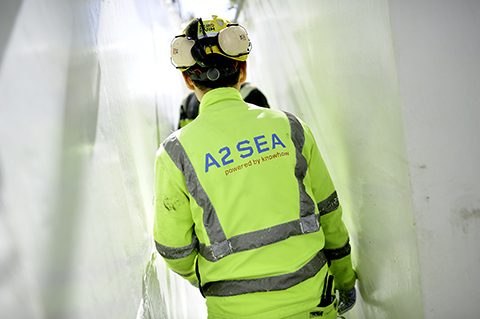
By Kirsten Bank Christensen, Vice President, HSEQ, A2SEA
Mobilisation projects are a valuable opportunity for cooperatively improving site safety together with many suppliers. This is the second of two posts describing how A2SEA’s ZERO HARM Mobilisation can lift supplier safety performance, and focusing on induction, HAZID/HAZOP workshops as well as results and learnings.
Thorough induction
A2SEA’s Site Safety Manager welcomes all new arrivals with a thorough site induction. A highly visual approach communicates the company’s principles, work access, interface management, emergency procedures, stop-work policy. Additionally the Site Safety Managers, with their broader focus on HSEQ awareness and safety culture, work together with mobilisation crew, training them in HSEQ risks and performing hazard hunts together with the crew and sub-contractors.
High-impact safety campaigns also assist, exerting concentrated efforts to encourage appropriate behaviours. Examples include a ‘Preventing Dropped Objects’ campaign and a recent ‘Work Wise – Think Twice’ campaign designed to help prevent injuries in the musculoskeletal system.
Workshops welcomed
HAZID/HAZOP workshops are another vital activity, involving all business partners and clarifying the scope of work, roles and responsibilities. These workshops have become a highly appreciated discipline that plays a key role in managing interfaces, integrating mitigation measures, residual risks and much more to ensure and improve safety.
Other highlights include thorough site inductions, a safe system of work emphasising risk management, and a Permit to Work procedure where mandatory toolbox talks precede any work, outlining the task and safety issues. Performance is measured both during and after each project and registered via A2SEA’s Synergi system, providing a solid data basis for identifying and carrying learnings to the next project.
Additionally, ZERO HARM Mobilisation takes account of the challenges introduced by work-culture differences. To effect cultural shifts, A2SEA supports suppliers in structuring their safety performance from planning and documentation to actual performance. Finally, A2SEA and its suppliers promptly review and discuss learnings.
Clear results
ZERO HARM Mobilisation pays off. Directly measurable results regarding the company’s own mobilisation projects alone demonstrate:
• A reduction in eye-related injuries
• An increase in the reporting of near misses and proactive safety observations
• Reduction to 0 in Lost Work Cases
• Reduction in the Potentially Life-changing events frequency
• Reduction in total recordable injuries
Learnings
The programme has shown that optimal safety is achieved when companies:
• Recognise the potential hazards of mobilisations, decide to make a difference and accept that now is the time to change
• Focus on supplier interactions – revealing numerous, often unexpected opportunities to make improvements
• Set customised targets based on the scope of work and the maturity of the workforce
• Involve business partners and workforce in dialogue and proactive solution-finding
Learnings transferred to sub-contractors are also likely to pay off on their own projects. Suppliers can adapt the practices to influence their own contractor networks, lifting their safety performance – and it is hoped that efforts to encourage broader data-sharing can reveal this impact during 2016. Finally, while the additional care and administrative resources demand more investment for each project, the company is still able to deliver all of its mobilisations on time and on budget – making ZERO HARM Mobilisation good for business, too.
Reaching out
To date, the principles of ZERO HARM Mobilisation have been widely adopted within A2SEA and among its suppliers. Now the company is moving to share the programme via RUK H&S 2016, and through WindEurope, SeaHealth and trade seminars.
With ZERO HARM Mobilisation, strong partnerships, meticulous planning and leadership ensure that mobilisations are performed with convincing and constantly improving safety performance.
Like this post? Subscribe now and get notified about new content!